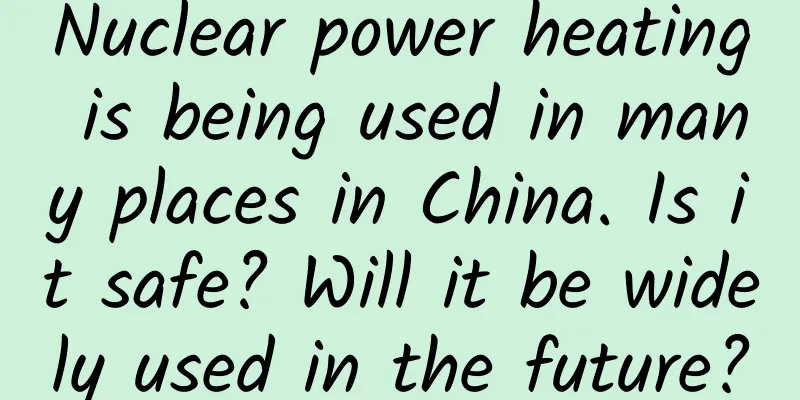Nuclear power heating is being used in many places in China. Is it safe? Will it be widely used in the future?

|
In Shandong, Liaoning, Zhejiang and other places, nuclear energy heating has served the surrounding residents. But there are rumors that the heating water heated by nuclear energy is radioactive. What is the truth? Written by Zhang Zili (Associate Researcher, Institute of Electrical Engineering, Chinese Academy of Sciences) Editor/Zhao Tianyu Liu Zhao In Haiyang, Shandong, the National Energy Investment Corporation's "Nuanhe No. 1" nuclear energy heating project recently began low-temperature trial operation. This is also the largest nuclear energy heating project in China, with a heating area of nearly 5 million square meters in the urban area and serving 200,000 residents. In Dalian, Liaoning, the nuclear energy heating demonstration project of the Hongyanhe Nuclear Power Plant was officially put into operation. This project is the first nuclear energy heating project in Northeast China, with a planned heating area of 242,400 square meters, which will provide winter heating for nearly 20,000 local residents. In Haiyan, Zhejiang, the first nuclear energy heating demonstration project in southern my country - China National Nuclear Corporation's Qinshan Nuclear Power Nuclear Energy Heating Demonstration Project is under construction. After the project is fully completed and put into operation by the end of the 14th Five-Year Plan, it will be able to meet the heating needs of about 4 million square meters and reduce the annual standard coal consumption by about 24,600 tons. However, many people still fear the word "nuclear". Nuclear heating plants are questioned as unsafe. There are even rumors that the water heated by nuclear energy is radioactive. What is the truth? Is nuclear heating a good way to solve the coal shortage? How does nuclear heating work? In the public's impression, "nuclear power" is the most familiar word, and the most direct application of nuclear energy seems to be power generation. In fact, the power generation principle of nuclear power plants, especially shell reactors, is very similar to that of traditional thermal power plants. Simply put, it is "boiling water". Therefore, nuclear power plants can also achieve cogeneration like thermal power plants, that is, both power generation and heat supply. One of the most common reactor types in nuclear power plants is the pressurized water reactor, which is also the reactor type used by the Haiyang Nuclear Power Plant. This type of reactor is to install the nuclear reactor in a "pressure cooker". The whole system consists of three circuits: one circuit is the core of the nuclear power plant, which is equivalent to the boiler of a thermal power plant. After the nuclear fission reaction occurs here, it generates huge heat, heating the high-pressure water to above 300°C. The water in the second circuit passes through the steam generator, absorbs the heat of the steam in the first circuit, and turns itself into saturated steam, which drives the steam turbine to do work and then turns into condensed water. The temperature of these condensed waters is basically more than 90 degrees, so they need to be cooled before processing. If heating is required, the water in the second circuit will enter another heat converter to heat another batch of water, which can also be called heating the water in the third circuit. This operation can continue to the fourth circuit, the fifth circuit or even more. The water that is finally output becomes the "heating water" that is transmitted to residents' homes. In addition to shell reactors, there is another type of reactor for nuclear heating called pool reactor. From the name, it seems that energy is output in a pool, which is indeed the case - the nuclear fuel rods are placed in a pool of purified water. Water can be used as a moderator and coolant, as well as a reflector and part of the protective layer. There are also heavy concrete shielding layers on the sides and bottom of the pool to effectively prevent radiation. If heating is required, the reactor core is placed deep in a normal pressure pool, and the static pressure of the water layer is used to increase the core outlet water temperature to meet the heating requirements. The heat is transferred to the heating circuit through two-stage exchange, and then the heat is delivered to thousands of households through the heat network. It is worth mentioning that shell heating reactors are generally not professional heat generators, but cogeneration, that is, they are mainly used for power generation, and the remaining energy is used for heat generation. The project in Haiyang, Shandong uses the waste heat from the Haiyang Nuclear Power Plant. ▲Schematic diagram of Haiyang nuclear energy heating (Photo source: Shandong Nuclear Power Co., Ltd.) Why is it said that nuclear heating has no "radiation"? For the public, the first thing to understand is that nuclear energy heating is not nuclear heating. Currently, there is no technology in the world that can directly use nuclear fuel as a heat source. It can only be achieved after layers of medium conversion. This principle is very similar to the self-heating hot pot we often eat - water is used as a medium to drive the heating pack to generate heat, generating hot air to heat the ingredients. In this process, the water and the ingredients have no contact at all. Back to the issue of "nuclear energy heating", whether it is a pool-type heating reactor or a shell-type heating reactor, they all extract steam as a heat source, and perform multi-stage heat exchange through the heat exchange station in the plant and the heat exchange station of the heating enterprise outside the plant, and finally transfer the heat to the end user through the municipal heating pipeline network. In the whole process, there are only two modes: "steam heating water" and "water heating water". There are multiple circuits to isolate the nuclear power plant from the heating users. There is only heat transfer between each circuit, and no water exchange, so no radioactive substances will enter the user's heating pipes. ▲Haiyang Nuclear Power Base (Photo source: The Paper) According to media reports, the nuclear heating in Haiyang, Shandong Province, extracts part of the steam from the nuclear power generator as a heat source, converts it into high-temperature water through the heat exchanger in the plant, and then transports it to the heating company through the pipeline network. The whole process involves up to 5 circuits. Another professional engineer said that before the hot water at the first heat exchange station of the nuclear power plant leaves the factory, the online monitoring and isolation devices will also be tested, and the pressure difference design is adopted between the circuits to ensure the safety and reliability of nuclear heating. As for residents, after testing, the water used by users does not have any radioactivity, and is consistent with various indicators of normal water use, "you can rest assured, it is very safe." Will a nuclear heating station "explode"? Not only does nuclear heating have no radiation, but the safety of nuclear heating stations is also very high. From a design point of view, the outside of the nuclear fuel will be wrapped with a special fuel cladding, and the primary circuit system of the shell-type heating reactor is installed in a closed plant called a containment. The containment can maximize the protection of the public and the environment from being affected when an accident occurs in a nuclear power plant. In fact, just like beer cannot burn because its alcohol concentration is too low, the concentration of uranium 235 used in nuclear reactors is only 3% to 5%, and nuclear weapons must reach more than 95% or even higher, so the nuclear reactor itself will not explode, and there is no risk of leakage. Judging from past accidents, there is only one reason for nuclear power plant explosions - lack of water. In the process of generating electricity, nuclear power plants must continuously inject cold water into the reactants to achieve circulation. If the circulation stops, the reactants will overheat and melt, inducing major accidents. The Chernobyl Nuclear Power Plant hoped to use steam to drive the turbine to generate electricity after the power outage, so it conducted an experiment, but tragically, an operational error occurred during the experiment, causing the reactor to overheat, and eventually a meltdown explosion and nuclear leakage occurred. ▲Third-generation nuclear power plant: Unit 5 of Yangjiang Nuclear Power Plant of China General Nuclear Power Group The accident at the Fukushima nuclear power plant in Japan is easier to understand. After the earthquake, the nuclear power plant units were shut down. After the backup diesel generators lasted for half an hour, the power system was completely destroyed by the tsunami. Eventually, all four units exploded, causing a serious nuclear leak accident. If the heating station also has a power outage, will the same mistake as Chernobyl be repeated? The answer is no, because all the newly built nuclear reactors in recent years have been upgraded to third-generation reactors. Compared with second-generation reactors like Fukushima, their biggest feature is that they have a "passive" cooling function - they can be cooled naturally without an external power supply, which greatly enhances the safety factor. As for pool-type reactors, because the nuclear fuel reacts directly in the water, the energy generated directly freezes the water temperature at around 100 degrees Celsius, and there is no need for cooling water at all, which simplifies the complexity of the energy conversion equipment system and reduces the loss of the energy conversion process. The safety factor is higher than that of traditional shell-type reactors. Will nuclear heating become widely popular in the future? Compared with other forms of heating such as traditional fossil energy, nuclear energy heating has very obvious environmental advantages: nuclear fission has a high energy density. Compared with coal-fired boilers of the same power, the annual transportation volume of nuclear fuel is only about one hundred thousandth of the amount of coal; nuclear energy heating can also significantly reduce carbon dioxide emissions, which coincides with the needs of "carbon reduction" and "carbon neutrality". In northern my country, the livelihood needs of centralized heating have become the main obstacle to carbon reduction and carbon neutrality. Under this pressure, the future of thermal power plants will not be easy. It can be said that the realization of nuclear energy heating has brought new hope to thermal power companies. In fact, nuclear energy heating is not a new concept. As early as half a century ago, it was used in Northern Europe, and the Soviet Union also built nuclear energy heating reactors. my country has carried out relevant research as early as the 1980s. Even by the end of 2017, some office buildings of the China National Nuclear Corporation's Institute of Atomic Energy Science had begun to use the "Yanlong" swimming pool-type low-temperature heating reactor developed by itself for heating. So, what is the reason why nuclear energy heating has not been popularized so far? Economic factors are very important. ▲Schematic diagram of pool-type nuclear energy heating Pool-type heating reactors are also called small reactors. Although they are convenient and flexible, they sacrifice heating efficiency at the current technical level. They can only be used in small areas, such as parks, campuses or small towns. They cannot benefit the general public, do not solve the substantive problem of heating, and instead face great economic pressure. The other is based on existing medium and large nuclear power plants, using the extraction steam of nuclear power plants to supply heat to the heat network. This is the model used in Haiyang, Shandong. The extraction steam temperature and pressure are determined by the demand of the heat network and the length of the heat transmission pipeline. However, this model also has disadvantages. Nuclear power plants require a lot of cold water support, which is not suitable for construction in inland areas of my country, especially in water-scarce areas in the north. If it is only built on the seaside to supply heat to the inland, not only will it cost a lot to build heat conduction equipment, but the heat loss during the conduction process will also be amazing. In summary, it is not difficult to draw the following conclusion: Nuclear heating is good, but it is not easy to popularize it on a large scale. In fact, nuclear heating is a complex task, involving many aspects such as market, technology and policy. The nuclear heating in Haiyan, Zhejiang, Dalian, Liaoning and Haiyang, Shandong has taken a substantial step forward, which plays an important guiding role in optimizing regional energy structure, regional clean heating and zero-carbon heating, and also points out the direction for the future development and application of nuclear heating technology. ■ (Part of the content comes from CCTV Finance) |
>>: "The Earth weighs about 6 ronna grams"
Recommend
The latest tea tasting guide in Chengdu in 2022
2022 Chengdu Latest Tea Tasting Guide Appointment...
How to learn planning and development projects?
The planners I have seen, whether they are from t...
How to build the NetEase Yanxuan membership system?
NetEase Yanxuan, a self-operated lifestyle e-comm...
Shanghai General Motors: Work Secretary [WeChat Enterprise Account Case]
As an information announcement platform for the p...
Traffic monetization: How to identify and select better advertising aggregation platforms?
In the first half of the mobile Internet , what p...
How much does it cost to develop a makeup mini app in Huai'an?
Is it easy to develop a Huai'an makeup mini p...
EleCloud review: a mobile power bank with storage and sharing functions
First of all, let me make it clear here that EleC...
Do you get angry easily? Do you always suppress yourself? Here are 5 tips to help you master your emotions!
Joy, anger, sorrow, thought, sadness, surprise, a...
I only understood this after working for 10 years. If I had known earlier, my position would have been two levels higher than it is now.
No matter what industry you are working in now, n...
Smart routing bubble emerges more like a "small door" than an "entrance"
Since JiRoute took the lead in launching the conc...
App Store's ability to make money is amazing. Apple's software service strength makes Android tremble
Apple announced today that the App Store broke a ...
It’s too hot! Even the trees are starting to move | Environmental Trumpet
Hello everyone, this is the 15th issue of the Env...
What kind of programmer is a programmer who wrote 1 million lines of code?
Today, I was browsing the social network and sudd...
11 years ago today, the J-20 made its first successful flight! So this is what the first flight time means...
Inside Aviation Industry Chengdu Aircraft Corpora...
Google Chrome App will be discontinued in June 2022 and transformed into PWA application
On October 15, according to foreign media 9to5Goo...









